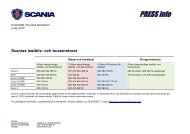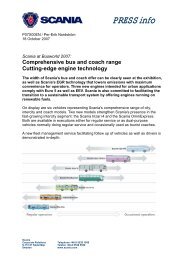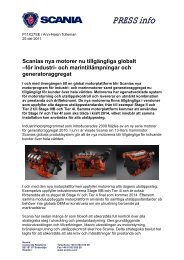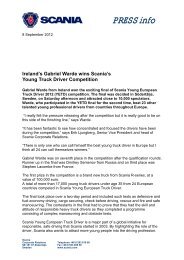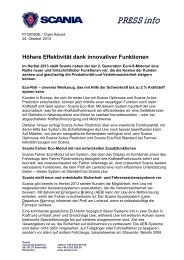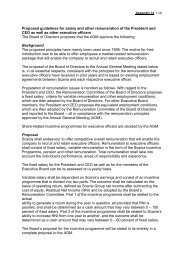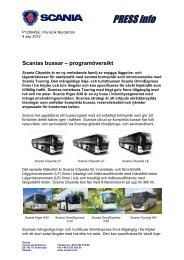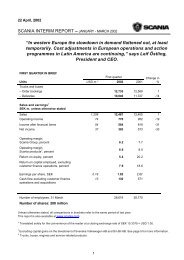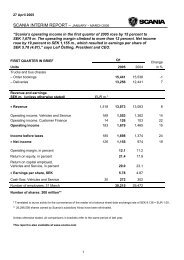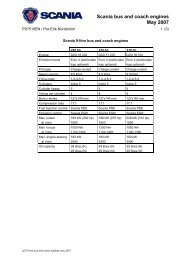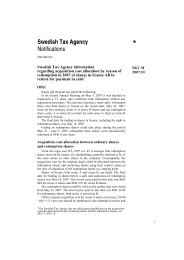Scania annual report 2003
Scania annual report 2003
Scania annual report 2003
Create successful ePaper yourself
Turn your PDF publications into a flip-book with our unique Google optimized e-Paper software.
value, the recoverable amount of the asset is<br />
estimated. If the recoverable amount is less than<br />
the carrying amount, the asset is written down<br />
to its recoverable amount.<br />
In case of a financial lease, where <strong>Scania</strong> is<br />
the lessee, the leased asset is <strong>report</strong>ed as a<br />
tangible asset and the future commitment as a<br />
liability.<br />
Intangible fixed assets<br />
<strong>Scania</strong>’s intangible assets consist of goodwill on<br />
consolidation plus capitalised expenditures for<br />
development of new products as well as software.<br />
Goodwill on consolidation arises when the<br />
acquisition value of shares in a subsidiary<br />
exceeds the value of that company’s net assets<br />
according to the acquisition analysis. The amortisation<br />
period for goodwill on consolidation is<br />
established on the basis of individual examination.<br />
In deciding the amortisation period, the<br />
main principles used are as follows:<br />
– Small acquisitions that are a supplement to<br />
existing operations and that are integrated with<br />
them are amortised in five years.<br />
– Larger acquisitions that involve establishment<br />
of operations in new markets are amortised in<br />
ten years if they are established operations with<br />
a strong market position.<br />
<strong>Scania</strong>’s research and development activities<br />
are classified into a research phase and a development<br />
phase. Those expenditures that arise<br />
during the research phase are charged to earnings<br />
as they arise. Expenditures during the development<br />
phase are capitalised as an intangible<br />
fixed asset, beginning on the date when the<br />
expenditures are highly likely to lead to future<br />
economic benefits. The amortisation of capitalised<br />
development expenditures begins when the<br />
asset is placed in service and continues during<br />
its estimated useful life. For capitalised product<br />
development expenditures, the average useful<br />
life is currently estimated at five years. For capitalised<br />
software development expenditures, the<br />
useful life is estimated at between three and five<br />
years.<br />
If there is any indication on the balance sheet<br />
date that an intangible asset has diminished in<br />
value, the recoverable amount of the asset is<br />
estimated. If the recoverable amount is less than<br />
the carrying amount, the asset is written down<br />
to its recoverable amount.<br />
Inventories<br />
Inventories are valued at the lower of acquisition<br />
value and net realisable value according to the<br />
first in, first out (FIFO) principle. An allocable<br />
portion of indirect expenses is included in the<br />
value of the inventories.<br />
Short-term investments<br />
Short-term investments are valued at the lower of<br />
accrued acquisition value and fair value.<br />
Liquid assets<br />
Liquid assets consist of cash and bank balances<br />
as well as short-term investments. In some<br />
cases, short-term investments consist of investments<br />
with maturities that are formally longer<br />
than 90 days, but which can easily be turned<br />
into liquid assets.<br />
Financial instruments<br />
Financial assets, including interest-bearing<br />
receivables in Customer Finance, are <strong>report</strong>ed<br />
at accrued acquisition value minus probable<br />
credit losses. Provisions for bad debts are made<br />
individually, based on the customer’s payment<br />
capacity and the value of the collateral.<br />
Financial liabilities are <strong>report</strong>ed at accrued<br />
acquisition value. Premiums or discounts as well<br />
as transaction costs when issuing securities are<br />
allocated over the maturity of the loan.<br />
Financial assets and liabilities in foreign<br />
currencies are valued according to the principles<br />
stated under “Foreign currencies”. For a description<br />
of the <strong>report</strong>ing of derivatives, see also<br />
Note 33.<br />
Provisions<br />
Provisions are recognised if an obligation<br />
(legal or informal) exists as a result of a past<br />
event. It must also be deemed likely that an outflow<br />
of resources will be required to settle the<br />
obligation and that the amount can be reliably<br />
estimated. Provisions for factory warranties on<br />
vehicles sold during the year are based on the<br />
applicable warranty terms and conditions and<br />
the estimated quality situation.<br />
Provisions for pensions<br />
Provisions for pensions are equivalent to the<br />
actuarial value of the collectively agreed ITP<br />
occupational pension plan and all voluntary<br />
pension obligations. The item “Provisions for<br />
pensions” includes foreign subsidiaries, with<br />
pension commitments <strong>report</strong>ed in compliance<br />
with the principles applicable in each respective<br />
country, provided that these signify that earned<br />
pension rights are <strong>report</strong>ed as expenses.<br />
Revenue recognition<br />
Revenue from the sale of goods and services is<br />
<strong>report</strong>ed when substantially all risks and rewards<br />
are transferred to the buyer. Sales revenue is<br />
reduced, where applicable, by discounts provided.<br />
If the sale is combined with a repurchase<br />
obligation or a residual value guarantee the transaction<br />
is <strong>report</strong>ed as, in accordance with normal<br />
industry practice, an operating lease provided<br />
that substantial risks remain with <strong>Scania</strong>. Leasing<br />
income, as well as interest income in the<br />
case of hire purchase financing, is recognised<br />
over the underlying contract period in compliance<br />
with the terms of the contract. Invoicing for<br />
both repair and maintenance agreements and<br />
for vehicles that could not yet be recognised as<br />
revenue, as provided above, is <strong>report</strong>ed as prepaid<br />
income.<br />
Research and development expenses<br />
Consists of the research and development expenditures<br />
that arise during the research phase<br />
plus amortisation during the period of capitalised<br />
development expenditures (see “Intangible<br />
assets”).<br />
Selling expenses<br />
Selling expenses are defined as operating expenses<br />
in sales and service companies plus<br />
goodwill amortisations related to acquisitions<br />
of sales and service companies and costs of<br />
corporate-level commercial resources.<br />
Administrative expenses<br />
Administrative expenses are defined as costs of<br />
corporate management as well as staff units<br />
and corporate service departments.<br />
Borrowing costs<br />
Borrowing costs in the form of interest are<br />
charged to earnings when they arise.<br />
Taxes<br />
The Group’s total tax consists of current and<br />
deferred tax. Deferred tax is recognised in case<br />
of a difference between the carrying amount of<br />
assets and liabilities and their fiscal value (“temporary<br />
difference”). Full provision is made for<br />
deferred tax liabilities. Deferred tax assets are<br />
recognised only to the extent that it is likely that<br />
they can be utilised.<br />
Related party transactions<br />
Related party transactions occur on market<br />
terms. The <strong>Scania</strong> Group’s related parties consist<br />
of the companies in which <strong>Scania</strong> can exercise<br />
a controlling or significant influence in terms<br />
of the financial and operating decisions that are<br />
made. The circle of related parties also includes<br />
those companies and physical persons that are<br />
able to exercise a controlling or significant influence<br />
over the financial and operating decisions<br />
of the <strong>Scania</strong> Group.<br />
Government grants<br />
Government grants received that are attributable<br />
to operating expenses reduce these expenses.<br />
Government grants related to investments reduce<br />
the gross acquisition value of the fixed<br />
assets.<br />
ANNUAL REPORT <strong>2003</strong><br />
58



